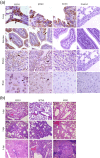Transmission of H7N9 influenza virus in mice by different infective routes
- PMID: 25367670
- PMCID: PMC4289364
- DOI: 10.1186/1743-422X-11-185
Transmission of H7N9 influenza virus in mice by different infective routes
Erratum in
-
Correction to: Transmission of H7N9 influenza virus in mice by different infective routes.Virol J. 2021 Jul 6;18(1):140. doi: 10.1186/s12985-021-01603-2. Virol J. 2021. PMID: 34229707 Free PMC article. No abstract available.
Abstract
Background: On 19 February 2013, the first patient infected with a novel influenza A H7N9 virus from an avian source showed symptoms of sickness. More than 349 laboratory-confirmed cases and 109 deaths have been reported in mainland China since then. Laboratory-confirmed, human-to-human H7N9 virus transmission has not been documented between individuals having close contact; however, this transmission route could not be excluded for three families. To control the spread of the avian influenza H7N9 virus, we must better understand its pathogenesis, transmissibility, and transmission routes in mammals. Studies have shown that this particular virus is transmitted by aerosols among ferrets.
Methods: To study potential transmission routes in animals with direct or close contact to other animals, we investigated these factors in a murine model.
Results: Viable H7N9 avian influenza virus was detected in the upper and lower respiratory tracts, intestine, and brain of model mice. The virus was transmissible between mice in close contact, with a higher concentration of virus found in pharyngeal and ocular secretions, and feces. All these biological materials were contagious for naïve mice.
Conclusions: Our results suggest that the possible transmission routes for the H7N9 influenza virus were through mucosal secretions and feces.
Figures




Similar articles
-
Mammalian Pathogenesis and Transmission of H7N9 Influenza Viruses from Three Waves, 2013-2015.J Virol. 2016 Apr 14;90(9):4647-4657. doi: 10.1128/JVI.00134-16. Print 2016 May. J Virol. 2016. PMID: 26912620 Free PMC article.
-
Transmissibility of novel H7N9 and H9N2 avian influenza viruses between chickens and ferrets.Virology. 2014 Feb;450-451:316-23. doi: 10.1016/j.virol.2013.12.022. Epub 2014 Jan 14. Virology. 2014. PMID: 24503095
-
Transmission of H7N9 Influenza Viruses with a Polymorphism at PB2 Residue 627 in Chickens and Ferrets.J Virol. 2015 Oct;89(19):9939-51. doi: 10.1128/JVI.01444-15. Epub 2015 Jul 22. J Virol. 2015. PMID: 26202239 Free PMC article.
-
Genetic tuning of avian influenza A (H7N9) virus promotes viral fitness within different species.Microbes Infect. 2015 Feb;17(2):118-22. doi: 10.1016/j.micinf.2014.11.010. Epub 2014 Dec 11. Microbes Infect. 2015. PMID: 25498867 Review.
-
H7N9: a low pathogenic avian influenza A virus infecting humans.Curr Opin Virol. 2014 Apr;5:91-7. doi: 10.1016/j.coviro.2014.03.001. Epub 2014 Apr 3. Curr Opin Virol. 2014. PMID: 24705093 Free PMC article. Review.
Cited by
-
Experimental Infection of Rats with Influenza A Viruses: Implications for Murine Rodents in Influenza A Virus Ecology.Viruses. 2025 Mar 29;17(4):495. doi: 10.3390/v17040495. Viruses. 2025. PMID: 40284938 Free PMC article.
-
Mammalian Pathogenesis and Transmission of H7N9 Influenza Viruses from Three Waves, 2013-2015.J Virol. 2016 Apr 14;90(9):4647-4657. doi: 10.1128/JVI.00134-16. Print 2016 May. J Virol. 2016. PMID: 26912620 Free PMC article.
-
Avian Influenza Viruses, Inflammation, and CD8(+) T Cell Immunity.Front Immunol. 2016 Mar 1;7:60. doi: 10.3389/fimmu.2016.00060. eCollection 2016. Front Immunol. 2016. PMID: 26973644 Free PMC article. Review.
-
Influenza H7N9 virus disrupts the monolayer human brain microvascular endothelial cells barrier in vitro.Virol J. 2023 Sep 29;20(1):219. doi: 10.1186/s12985-023-02163-3. Virol J. 2023. PMID: 37773164 Free PMC article.
-
Quantitative measurement of influenza virus transmission in animal model: an overview of current state.Biophys Rev. 2023 Sep 7;15(5):1359-1366. doi: 10.1007/s12551-023-01113-1. eCollection 2023 Oct. Biophys Rev. 2023. PMID: 37975001 Free PMC article. Review.
References
-
- Gao R, Cao B, Hu Y, Feng Z, Wang D, Hu W, Chen J, Jie Z, Qiu H, Xu K, Xu X, Lu H, Zhu W, Gao Z, Xiang N, Shen Y, He Z, Gu Y, Zhang Z, Yang Y, Zhao X, Zhou L, Li X, Zou S, Zhang Y, Li X, Yang L, Guo J, Dong J, Li Q, et al. Human Infection with a Novel Avian-Origin Influenza A (H7N9) Virus. N Engl J Med. 2013;368(20):1888–1897. doi: 10.1056/NEJMoa1304459. - DOI - PubMed
Publication types
MeSH terms
LinkOut - more resources
Full Text Sources
Other Literature Sources
Medical

